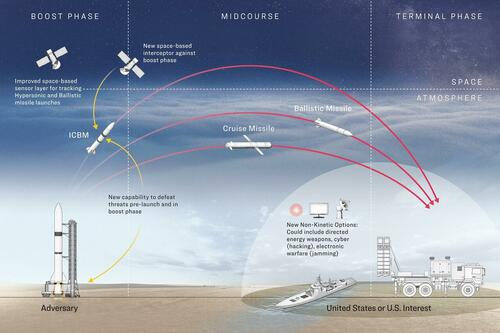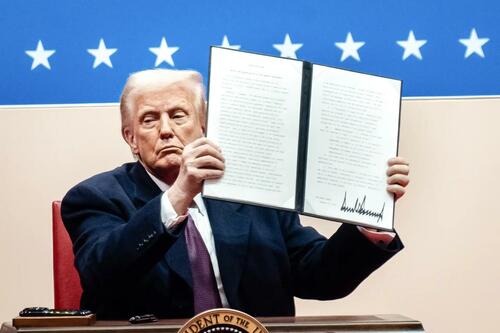Authored by Ryan Morgan via The Epoch Times (emphasis ours),
The U.S. Missile Defense Agency is already searching for cutting-edge missile defense technologies after President Donald Trump signed a new executive order, calling for an “Iron Dome for America.”

The executive order gave the Department of Defense 60 days to evaluate the U.S. missile defense network and overhaul it with hypersonic weapon sensors, space-based missile interceptors, and other so-called “non-kinetic” missile defense capabilities.
Trump has also tasked military leaders with conceiving new ways to stop incoming threats earlier than ever before, including before they launch.
Four days after Trump signed the order, the Missile Defense Agency published a request for information from arms industry insiders on promising advancements to meet Trump’s call for a better missile defense shield.
The quick turnaround suggests the Trump administration is urgently pursuing advanced new strategic defenses at a moment of growing U.S. competition with Russia and China.
Both nations have made advances in offensive strategic weapons technology in recent years, and the U.S. military has struggled to keep pace.
While Trump’s order calls for several new missile defense capabilities, a major focus is on evaluating what systems already exist and whether they’re deployed in the right manner to protect the United States and forward-deployed U.S. troops and allies.
Daniel Flesch, a senior policy analyst for the Allison Center for National Security at the Heritage Foundation, described Trump’s order as a holistic approach that expands on capabilities the U.S. military already has.

“Where are the gaps, and where do we need to develop or invest?” Flesch told The Epoch Times.
The launch trajectory of a strategic weapon like a nuclear-armed intercontinental ballistic missile (ICBM) is generally divided into three phases.
The “boost phase” is the initial stage as a weapon burns its propellant at launch. After a ballistic missile expends most of its propellant in the liftoff, it begins its main course of flight toward its target, known as the “midcourse.”
Finally, after reaching the apex of its trajectory, a ballistic missile will fall toward its target in what’s known as the “terminal phase” of its trajectory.
The U.S. Navy currently has both land and ship-based variants of the SM-3 missile that can intercept enemy ballistic missiles in space, at the height of their mid-course flight. The U.S. Army also has ground-based interceptors for mid-course interceptions.
For ballistic missile interceptions in the terminal phase of flight, the Navy has the ship-based SM-6 missile, while the Army has the Terminal High Altitude Area Defense system and newer variants of the Patriot air-defense missile system.
The midcourse presents the largest window for an intercept but requires sophisticated interceptors capable of reaching ballistic missiles at high altitudes, including in space.
Terminal phase interceptors don’t have to reach as high as midcourse interceptors, but it’s a narrow and high-stakes window to stop a ballistic missile before it reaches its final target.
The boost phase presents an attractive opportunity to stop a missile threat because the missile is less capable of evading interceptors or deploying decoys, but detecting a launch in this early stage is difficult, as is having an effective system in position to stop it.

Along with new and improved sensors for tracking the trajectory of weapons throughout their flight, Trump’s order envisions a network of space-based interceptors that could stop threats in their boost phase.
Weapons researchers have long considered high-powered lasers as one potential option for boost phase interceptions.
The United States and Israel have both seen advancements with lasers for intercepting drones and missiles, but more improvements may be needed to effectively counter sophisticated ballistic missiles.
Trump’s order could potentially renew development for an airborne laser system for boost-phase interceptions, such as the U.S. Air Force’s shelved Boeing YAL-1 airborne laser aircraft.
Trump’s Iron Dome for America takes direct inspiration from the Strategic Defense Initiative (SDI), a missile defense program President Ronald Reagan put in motion in 1983.
“President Ronald Reagan endeavored to build an effective defense against nuclear attacks, and while this program resulted in many technological advances, it was canceled before its goal could be realized,” Trump’s order states.
SDI indeed looked to develop space-based and non-kinetic interception capabilities that many critics dismissed as figments of science fiction. The initiative was referred to, often derisively, as Reagan’s “Star Wars” program.
Trump’s concept for a network of space-based interceptors bears a close resemblance to at least one SDI concept, codenamed “Brilliant Pebbles,” which called for the deployment of potentially thousands of small satellites, each armed with interceptors to stop enemy ballistic missiles in the boost phase.
Read the rest here...